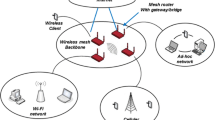Abstract
In a multirate wireless network, low data rate nodes consume proportionately more channel resources than high data rate nodes, resulting in low overall network performance. The use of multiple non-overlapping frequency channels in multirate wireless networks can overcome the performance degradation by having nodes communicate on different channels based on their data rates. However, no effort has been invested to utilize the multiple channels for a multirate wireless network. In this paper, we introduce the Data Rate Adaptive Channel Assignment (DR-CA) algorithm for a multichannel multirate single-hop wireless network to provide higher network throughput and network efficiency. The main idea is to assign links having same or comparable data rates on the same channel to minimize the wastage of channel resources due to interference between high data links and low data rate links. We also design a new Intermediary Multichannel Layer (IML) which resides between network layer and link layer, at which we implement the DR-CA algorithm. The IML design requires no modifications to the underlying MAC layer and upper layers of the network stack. To evaluate the proposed algorithm we define new performance metrics—channel efficiency and network efficiency for a multichannel multirate wireless network. Using OPNET simulations, we show that the multichannel enhancement using our proposed algorithm provides significant performance improvement in terms of network throughput, channel efficiency, and network efficiency over existing approaches in multirate wireless networks. Under heavy load condition, the network efficiency using DR-CA algorithm reaches 90% of the maximum limit. To the best of our knowledge, this is the first work to utilize the benefits of multiple channels in the multirate wireless network environment.
Similar content being viewed by others
References
Adya, A., Bahl, P., Padhye, J., Wolman, A., & Zhou, L. (2004). A multi-radio unification protocol for IEEE 802.11 wireless networks. In Proceedings of IEEE International Conference on Broadband Networks (Broadnets).
ANSI/IEEE Standard 802.11, 1999 Edition [ISO/IEC DIS 8802-11] Wireless LAN Medium Access Control (MAC) and Physical Layer Specifications.
Awerbuch, B., Holmer, D., & Rubens, H. High throughput route selection in multi-rate ad hoc wireless networks, Lecture Notes in Computer Science, ISSN: 0302-9743, pp. 253–270.
Bahl, P., Chandra, R., & Dunagan, J. (2004, September). SSCH: slotted seeded channel hopping for capacity improvement in IEEE 802.11 ad-hoc wireless networks. In Proceedings of ACM MobiCom, Philadelphia, Pennsylvania.
De Couto, D. S. J., Aguayo, D., Bicket, J., & Morris, R. (2003, September). A high-throughput path metric for multi-hop wireless routing. In Proceedings of the 9th ACM International Conference on Mobile Computing and Networking (MobiCom ’03). San Diego, California.
Draves, R., Padhye, J., & Zill, B. (2004). Routing in multi-radio, multi-hop wireless mesh networks, In ACM Mobicom.
Gass, J. H., Pursley, M. B., Russell, H. B., Saulitis, R. J., Wilkins, C. S., & Wysocarski, J. S. (1998, October). Adaptive transmission protocols for frequency-hop radio networks. In Proceedings of the 1998 IEEE Military Communications Conference, volume 2, pp. 282–286.
Haas, Z. J., & Deng, J. (2002, June). Dual busy tone multiple access (DBTMA)—a multiple access control scheme for ad hoc networks. IEEE Transactions on Communications, 50(6), 975–985.
Herzel, F., Fischer, G., & Gustat, H. (2003, October). An integrated CMOS RF synthesizer for 802.11a wireless LAN. IEEE Journal of Solid-State Circuits, 18(10).
Holland, G., Vaidya, N., & Bahl, P. (2001). A rate-adaptive MAC protocol for multi-hop wireless networks. In Proceedings of ACM MOBICOM’01. Rome, Italy.
IEEE Computer Society (1997). 802.11: Wireless LAN Medium Access Control (MAC) and Physical Layer (PHY) Specifications. June [22] OPNET Modeler. Available: http://www.opnet.com.
IEEE Std. 802.11 (1999). Wireless LAN Media Access Control (MAC) and Physical Layer (PHY) Specifications, Available: http://standards.ieee.org/getieee802/.
Kameraman, A., & Monteban, L. (1997, Summer). WaveLAN-II: a high-performance wireless LAN for the unlicensed band. Bell Labs Technical Journal, 118–133.
Kearfott, R. B., & Kreinovich, V. (2005). Beyond convex? Global optimization is feasible only for convex objective functions: a theorem, Journal of Global Optimization, 33(4), 617–624.
Kyasanur, P., & Vaidya, N. H. (2004, October). Routing and interface assignment in multichannel multiInterface wireless networks. Tech. Rep., University of Illinois at Urbana-Champaign.
Maxim 2.4 GHz 802.11b Zero-IF Transceivers. Available: http://pdfserv.maxim-ic.com/en/ds/MAX2820-MAX2821.pdf.
Muir, A., & Garcia-Luna-Aceves, J. J. (1998). A channel access protocol for multihop wireless networks with multiple channels. In Proceedings of IEEE ICC, Atlanta, Georgia, June 7–11.
Multichannel WLAN Switching Engine. Available: http://www.engim.com.
Nasipuri, A., & Das, S. R. (1999, September). A multichannel CSMA MAC protocol for mobile multihop networks. In Proceedings of IEEE WCNC. New Orleans.
Prasad, A. R., & Moelard, H. (1999, March). WaveLAN-II system design note 225: enhanced data rate control.
Ramanathan, R., & Steenstrup, M. (1998, June). Hierarchically-organized, multihop mobile wireless networks for quality-of-service support. Mobile Networks and Applications, 3(1), 101–119.
Sadeghi, B., Kanodia, V., Sabharwal, A., & Knightly, E. (2002, September). Opportunistic media access for multirate ad hoc networks. In Proceedings of ACM MOBICOM’02.
Sheu, S. T., Tsai, Y., & Chen, J. (2003). MR2RP: The multi-rate and multi-range routing protocol for IEEE 802.11 ad hoc wireless networks. Kluwer Journal on Wireless Networks, 9, 165–177.
So, J., & Vaidya, N. H. (2003, January). A multi-channel MAC protocol for ad hoc wireless networks. Technical report, Dept. of Com. Science, University of Illinois at Urbana-Champaign, Urbana-Champaign, Illinois.
So, J., & Vaidya, N. H. (2004, October). A routing protocol for utilizing multiple channels in multi-hop wireless networks with a single transceiver. Tech. Rep., University of Illinois at Urbana-Champaign.
Tang, Z., & Garcia-Luna-Aceves, J. J. (1999). Hop-reservation multiple access (HRMA) for ad-hoc networks. In Proceedings of IEEE Infocom.
Tzamaloukas, A., & Garcia-Luna-Aceves, J. J. (2001). A receiver-initiated collision-avoidance protocol for multi-channel networks. In Proceedings of IEEE INFOCOM. Anchorage, Alaska.
Author information
Authors and Affiliations
Corresponding author
Rights and permissions
About this article
Cite this article
Niranjan, Pandey, S. & Ganz, A. Design and Evaluation of Multichannel Multirate Wireless Networks. Mobile Netw Appl 11, 697–709 (2006). https://doi.org/10.1007/s11036-006-7796-7
Published:
Issue Date:
DOI: https://doi.org/10.1007/s11036-006-7796-7




